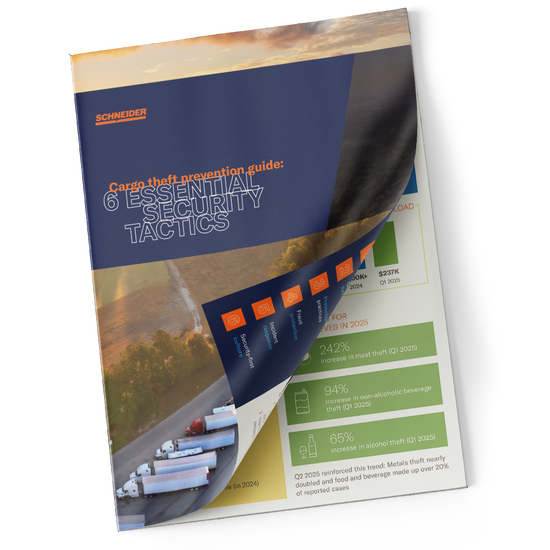Shipper | Blog 4 min. read
The growing threat of cargo theft

When goods move to their destination, the expectation is that they’ll arrive on time and intact. But in today’s environment, that’s not always guaranteed. Cargo theft has become one of the most pressing risks in transportation, and shippers across North America are feeling the impact.
As supply chains grow more complex and valuable, so do the opportunities for disruption. One of the most alarming challenges facing shippers today is cargo theft—a threat that’s no longer limited to physical goods being stolen, but now includes sophisticated schemes that exploit digital and operational vulnerabilities.
What is cargo theft?
Cargo theft is the criminal taking of freight from trucks, warehouses or supply chain facilities. But in recent years, it has expanded beyond stolen trailers and hijacked loads to include fraud, cyber manipulation and insider collusion. For shippers, this means the threat is not only widespread—it’s evolving.
Cargo theft statistics
Recent cargo theft statistics paint a clear picture:
- In 2024, cargo theft incidents in the U.S. and Canada reached 3,625 cases, a 27% increase from 2023.
- The total value of stolen goods climbed to nearly $455 million, up from $332 million the year before.
- On average, each incident cost shippers about $202,000.
- Some regions saw sharper spikes—California thefts rose 33%, and Texas incidents jumped 39%. Together with Illinois, these three states made up nearly half of all U.S. cases.

Each quarter in 2024 showed year-over-year growth. Q1 posted the most alarming spike when thefts rose 46% compared to Q1 2023. These numbers highlight that cargo theft isn’t just happening more often. Theft is hitting harder, with thieves targeting higher-value loads.
Why cargo theft risk is rising
Several industry factors have combined to make freight particularly vulnerable:
Supply chain pressures
Tight trucking capacity, strong consumer demand and bottlenecks mean valuable loads are often sitting idle in yards or waiting in transit. For criminals, freight idling time is opportunity.
Complex logistics networks
Shippers frequently collaborate with multiple brokers and subcontracted carriers. While this flexibility keeps goods moving, it also creates fragmentation that makes it harder to enforce consistent security standards.
Digital dependence
As freight management increasingly shifts online, criminals are taking advantage of digital systems. Cyber tactics have become a major entry point for theft. Common actions include hacking into load boards or dispatch platforms.
Workforce turnover
Driver shortages and high turnover can leave shippers vulnerable. New or less-experienced drivers may not follow strict security protocols. In some cases, insider collusion plays a role.
In short, modern supply chains present more attack opportunities than ever before.

4 cargo theft trends: How criminals are evolving
The newest cargo theft trends reveal just how adaptable and strategic modern thieves have become:
Fraud and deception schemes
Perhaps the most troubling trend is the rise of “theft by deception.” Criminals are now posing as legitimate carriers or brokers to arrange pickups. Known as fictitious pickups, these scams allow thieves to drive away with a load using nothing more than falsified paperwork or hacked communication.
CargoNet data shows these scams have grown significantly. Some reports cite a 600% increase in just six months due to fraud exploiting digital processes. In today’s environment, the thief is as likely to carry a laptop as a crowbar.
Commodity targeting
Criminals follow the money. Shipments of high-end electronics and other easily resold goods have seen sharp increases in theft. These patterns show thieves are tracking market trends. They deliberately target the loads with the greatest black-market value.
Geographic concentration
While cargo theft is a nationwide issue, it is particularly concentrated in freight-dense states. California, Texas and Illinois alone accounted for nearly half of all U.S. cases in 2024. Proximity to major ports, interstates and distribution centers makes these areas especially vulnerable.
Cyber-physical blend
Modern criminals don’t limit themselves to one method. Increasingly, cargo theft involves a mix of cyber manipulation and physical theft. A common example is when hackers access freight platforms to redirect shipments. They then coordinate with drivers or accomplices to physically move the stolen goods.
The ripple effects of cargo theft
The cost of a stolen load extends well beyond the value of the goods:
Financial impact
While insurance may cover part of the loss, companies still face deductibles, replacement costs, and potential profit loss. The National Insurance Crime Bureau and the Department of Homeland Security estimate total annual losses from cargo theft in the U.S. to be about $35 billion.
Supply chain disruption
If key raw materials or components are stolen, production lines may halt. Retailers risk stockouts and missed sales targets. For just-in-time operations, a single theft can derail entire schedules.
Reputation damage
Customers expect reliability. Repeated theft incidents can damage a company’s reputation and erode trust, especially if sensitive products like pharmaceuticals or food are involved.
Insurance challenges
Rising theft rates have pushed premiums higher, sometimes by double-digit percentages. Insurers are also tightening coverage, excluding high-theft commodities or requiring strict protocols for claims to be valid (such as GPS tracking or secure parking).
Regulatory complications
Certain industries, like food and pharma, may be required to recall stolen goods due to safety concerns, even if recovered. That adds compliance costs and potential brand damage.
Taken together, cargo theft causes ripple effects that go far beyond the initial loss.
Protect your business against cargo theft
The rising cargo theft statistics and evolving cargo theft trends should serve as a wake-up call. By understanding what cargo theft is, why it’s increasing and how criminals are adapting, shippers can take responsible, decisive steps to safeguard freight.

Take control of cargo security
Discover essential cargo theft prevention strategies in this free guide.
Related resources
Drive your business forward
Sign up to receive our industry leading newsletter with case studies and insights you can put to use for your business.












